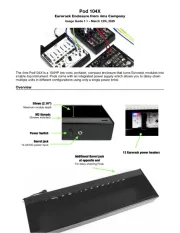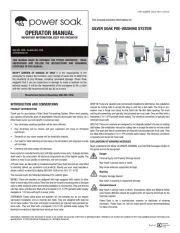4ms Shuffling Clock Multiplier Handleiding
4ms
Niet gecategoriseerd
Shuffling Clock Multiplier
Bekijk gratis de handleiding van 4ms Shuffling Clock Multiplier (4 pagina’s), behorend tot de categorie Niet gecategoriseerd. Deze gids werd als nuttig beoordeeld door 68 mensen en kreeg gemiddeld 4.3 sterren uit 34.5 reviews. Heb je een vraag over 4ms Shuffling Clock Multiplier of wil je andere gebruikers van dit product iets vragen? Stel een vraag
Pagina 1/4

4ms Shuffling Clock Multiplier
Eurorack Module User Manual v1.0.4
4ms Pedals
http://www.4mspedals.com/scm.php
Features
• Multiply-by-1 to Multiply-by-8, on 8 output jacks
• Maximum Multiply-by-32 with optional breakout panel
• Five Slipped/Shuffled/Skipped clock outputs (S3, S4, S5, S6, S8). Each is based
on a multiple of the input clock frequency (x3, x4, x5, x6, and x8, respectively)
• Three steady clock outputs (x1, x2, and x8), which are not effected by
Slip/Shuffle/Skip effects
• CV Rotate jack to shift multiply-by amount on all jacks
• CV Slip causes particular beats to land ahead in time
• Optional breakout panel: (see separate manual)
• CV Shuffle jack and knob selects which beats are “slipped” by CV Slip
(default=every other beat)
• CV Pulse Width jack and knob controls width of output pulses (default=50%)
• CV Skip jack and knob omits certain beats in a pattern (default=no skip)
• Re-sync CV Trigger input
• Additional CV Rotate and CV Slip jacks on breakout panel
• “4x Fast” CV jack and switch speeds up multiply-by amounts
• “Mute” CV jack and switch stops any more beats from starting
• UART header
• Connects to optional MIDI breakout panel (forthcoming)
• Arduino-compatible
• ISP header
• Connects to in-circuit programmer such as AVR ISP MKII for reprogramming code
• Maximum input frequency 3kHz
• 4 H.P. Eurorack module
• 60mA power draw (+/-12V or +/-15V)
Jacks
• Clock Input (3.5V to 15V clock, rising edge triggered)
• CV Rotate (0V to +5.1V input)
• CV Slip (0V to +5.1V input)
• Multiplied Clock Outputs (8 jacks):
• Multiply-by (1+R)
• Multiply-by (2+R) and slip/shuffle/skip
• Multiply-by (3+R) and slip/shuffle/skip
• Multiply-by (4+R) and slip/shuffle/skip
• Multiply-by (5+R) and slip/shuffle/skip
• Multiply-by (6+R) and slip/shuffle/skip
• Multiply-by (7+R) and slip/shuffle/skip
• Multiply-by (8+R)
...where R is the CV Rotation (0 to 7)

Jumpers
There are six jumpers on the back, and all jumpers should normally be in place
unless the breakout board is in use. The bottom three pins (one single pin, and a
row of two pins) do not get a jumper. The six jumpers set the extra features to
their defaults (CV Shuffle, Skip, PWM, Fast, Faster). If the jumpers are removed,
the various settings will “float” and change randomly. Beware that running more
than 5V, or less than 0V into any of these pins will permanently damage your
chip.
Ground “7”: 0V=Normal, 5V=Fastero o
Ground “8”: 0V=Normal, 5V=Fasto o
2.5V ref. “3”: 0-5V Pulse Width CVo o
Ground “4”: 0-5V: Skip CVo o
Ground “5”: 5V: Resync Trigger inputo o
Ground “6”: 0-5V: Shuffle CVo o
(no pin) +12/15V (mains supply)o
Slip CV Rotate CVo o
Operation
The SCM measures the , and uses that value to calculate the frequency of the clock time between the previous two pulses
signals on the output jacks. Applying a steady clock will produce an output clock of equal frequency on the p2-x1 jack, and a
clock of double the frequency on the p2-x2 jack... and a clock of eight times the frequency on the x8 jack.
Since the SCM only remembers the , you can simply “tap” it twice and it will run at time between the previous two pulses
that tempo indefinitely. There is inherently some tempo drift and human error in taking this “tap tempo” approach if your goal
is to synchronize the SCM to another clock, so it's recommended to use a common input clock when possible if sync'ing
tempos is desired. The SCM can handle rapidly changing clock signals, including complex waveforms that cross the 3.5V
boundary at erratic intervals.
Three of the jacks will always produce regular clock pulses that are multiples of the input clock: x1, x2, and x8. These jacks
are not effected by CV Slip or the breakout panel's Shuffle and Skip effects.
The other five jacks produce a clocks that are also multiples of the input clock, but these jacks will “rag” the beat (Slip and
Shuffle), as well as drop some beats out (Skip): S3, S4, S5, S6, S8.
Notice there is no S7 jack, this tempo pattern can only be produced by applying a CV to the Rotate jack. For example,
looking at the table below, we see that about 1.0V on the jack will make the S6 jack output S7, or Voltage at CV Rotate Jack
applying >5.1V will make the S8 jack output the S7 pattern. The reason for leaving out S7 was to make room for both S8 and
x8: playing a non-slipped and a slipped clock at the same time results in some fascinating phasing and variable-shifting
effects, especially if CV Slip is modulated slowly and both tempos are heard side-by-side.
Typically, the outputs will patch to trigger-able or gate-able modules (drum modules, ADSR envelope/transient generators,
step sequencer clock input, etc..), but the SCM can also operate in the audio frequency range, thus crudely stepping pitch
upward.

CV Slip
Slip is an effect where every “n” beats are shifted forward in time. By default, “n” is 2, so every other beat lands “late”: beats
2, 4, 6, etc... (The value of “n” can be changed by the Shuffle parameter, which is only controllable by the breakout panel.)
The amount each beat is late is set by CV Slip.
CV Slip operates between 0V and +5V. Zero volts is no slippage (0%) and 5V is about 90% slippage. When Slip is at 0V, the
“S” jacks act as straight “x” jacks (that is, there is no slipping/shuffling of the beat). Applying a small amount of CV to Slip
causes every other beat to land a little bit late. Applying the maximum CV (5V) causes every other beat to land right before
the next beat.
With no jack plugged into the CV Slip, the jack is normalized to about 2.5V. This translates to 50% slippage, which means
every other beat is played about halfway where it normally would fall and where the next beat normally falls.
Internally, there's a counter that keeps track of whether each beat should be slipped or not. This counter resets itself on each
input clock pulse. For example, if we have a steady regular clock input and we're slipping every other beat, then on the S5
jack beats 2 and 4 will be late. Then before beat 6 is supposed to happen, we have an input clock happening, so the counter
resets and beat 6 becomes beat 1 and is on time. So then beats 7 and 9 are late. The Slippage diagram illustrates this
interesting rhythm pattern.
Note that with the breakout panel, Pulse Width effects how much Slippage can occur. With very wide pulses, there's very little
time between the end of a beat and the start of the next beat— therefore there's very little room to push the beat forward
without encroaching upon the next beat. Therefore, the shorter the PW setting, the more dramatic the CV Slip effect.
Only the five “S” jacks are effected by CV Slip, no matter what the rotation is. That is, the slippage effect is linked to particular
jacks and the effect doesn't rotate with the multiply-by amounts.
See the pulse diagram on the last page to see how Slipping looks on a scope.
CV Rotation
By applying a CV signal to the CV Rotate jack, the clock multiples will rotate throughout the output jacks ( ). see table
The “S” jacks will always output a shuffled/slipped/skipped clock, and the “x” jacks will always output straight clock signals, no
matter how the clock signals are rotated
For more explanation of Rotation, see the Rotating Clock Divider manual– the rotation effect is the same for the SCM.
Multiply-by amounts at each jack
Jacks
Voltage at CV Rotate Jack
<1.0V 1.00V - 1.65V 1.65V - 2.30V 2.30V - 2.95V 2.95V-3.60V 3.6V-4.30V 4.30V-5.10V >5.1V
x1 x1 x2 x3 x4 x5 x6 x7 x8
x2 x2 x3 x4 x5 x6 x7 x8 x1
S3 S3 S4 S5 S6 S7 S8 S1 S2
S4 S4 S5 S6 S7 S8 S1 S2 S3
S5 S5 S6 S7 S8 S1 S2 S3 S4
S6 S6 S7 S8 S1 S2 S3 S4 S5
S8 S8 S1 S2 S3 S4 S5 S6 S7
x8 x8 x1 x2 x3 x4 x5 x6 x7
See the separate SCM Breakout manual for details on using CV Shuffle, CV Skip, CV
Pulse Width, 4x Fast, and Mute
Product specificaties
| Merk: | 4ms |
| Categorie: | Niet gecategoriseerd |
| Model: | Shuffling Clock Multiplier |
Heb je hulp nodig?
Als je hulp nodig hebt met 4ms Shuffling Clock Multiplier stel dan hieronder een vraag en andere gebruikers zullen je antwoorden
Handleiding Niet gecategoriseerd 4ms

2 Augustus 2025

4 Mei 2024

3 Augustus 2023

3 Augustus 2023

24 Juni 2023

16 Juni 2023

16 Juni 2023

2 Juni 2023

19 Mei 2023

15 Mei 2023
Handleiding Niet gecategoriseerd
- Shadow
- Crunch
- Sweex
- Best Service
- J.P. Instruments
- Hudson Valley
- Hosa
- Tusa
- PDMovie
- Duux
- Burley
- Signature
- Arco
- KKT Kolbe
- InFocus
Nieuwste handleidingen voor Niet gecategoriseerd

15 September 2025

15 September 2025

15 September 2025

15 September 2025

15 September 2025

15 September 2025

15 September 2025

15 September 2025

15 September 2025

15 September 2025